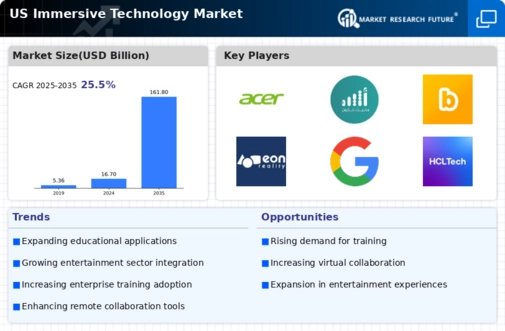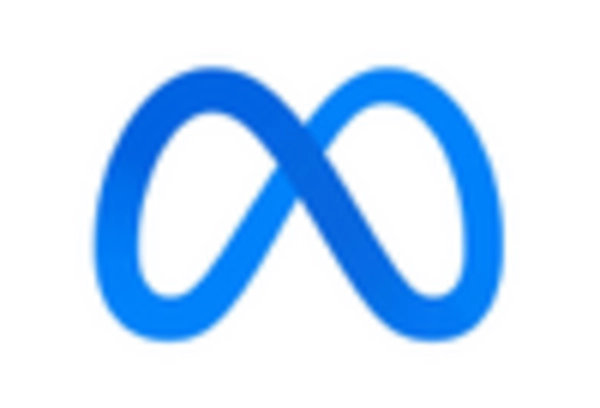The immersive technology market is currently characterized by a dynamic competitive landscape, driven by rapid advancements in hardware and software capabilities. Major players such as Meta Platforms (US), Microsoft (US), and Apple (US) are at the forefront, each adopting distinct strategies to enhance their market positioning. Meta Platforms (US) continues to focus on social virtual reality experiences, leveraging its extensive user base to drive engagement and content creation. Meanwhile, Microsoft (US) emphasizes enterprise solutions, integrating immersive technology into its existing software ecosystem to enhance productivity and collaboration. Apple (US), on the other hand, appears to be concentrating on consumer-oriented applications, particularly in augmented reality (AR), as it seeks to redefine user interaction with digital content. Collectively, these strategies contribute to a competitive environment that is increasingly centered around innovation and user experience.
In terms of business tactics, companies are increasingly localizing manufacturing and optimizing supply chains to enhance efficiency and responsiveness to market demands. The competitive structure of the immersive technology market is moderately fragmented, with a mix of established giants and emerging startups. This fragmentation allows for diverse innovation pathways, although the influence of key players remains substantial, shaping market trends and consumer expectations.
In October 2025, Meta Platforms (US) announced a partnership with a leading gaming studio to develop exclusive virtual reality content. This strategic move is likely to bolster Meta's content library, enhancing its appeal to gamers and reinforcing its position in the VR space. By focusing on exclusive content, Meta aims to differentiate itself from competitors and drive user engagement, which is crucial for sustaining its market leadership.
In September 2025, Microsoft (US) unveiled a new suite of mixed reality tools aimed at enterprise users, integrating AI capabilities to streamline workflows. This initiative underscores Microsoft's commitment to enhancing productivity through immersive technology, positioning it as a leader in the enterprise segment. The integration of AI not only improves user experience but also aligns with broader trends in digital transformation across industries.
In August 2025, Apple (US) launched a new AR development platform, designed to facilitate the creation of immersive applications for developers. This strategic initiative reflects Apple's focus on expanding its ecosystem and fostering innovation among third-party developers. By providing robust tools for AR development, Apple is likely to enhance its competitive edge in the consumer market, encouraging a wider adoption of AR technologies.
As of November 2025, current trends in the immersive technology market include a strong emphasis on digitalization, sustainability, and AI integration. Strategic alliances are increasingly shaping the competitive landscape, enabling companies to pool resources and expertise to drive innovation. Looking ahead, competitive differentiation is expected to evolve, with a shift from price-based competition towards innovation, technological advancements, and supply chain reliability. Companies that can effectively leverage these trends are likely to secure a more prominent position in the market.


















Leave a Comment